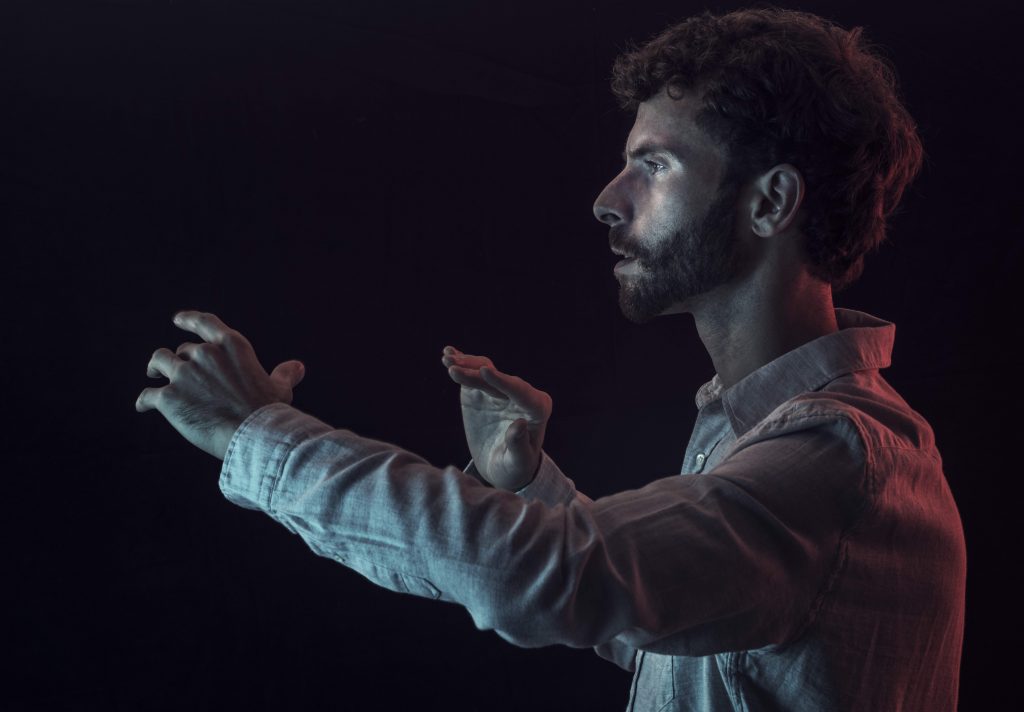Chamber Music on the Cutting Edge from Franz Joseph Haydn to Matthew Aucoin
“All music was new at one time,” quipped Matthew Aucoin Tuesday as he welcomed the audience to his “Hearing the Future” festival chamber music program in the Auditorium at TSRI. But to fit his festival theme, Aucoin chose pieces that were pivotal when they were written, displaying approaches that pointed to a musical future barely on the horizon.

Matthew Aucoin [photo (c.) Steven Laxton]
From Haydn, Aucoin leapt to Arnold Schoenberg’s early composition “Verklärte Nacht,” Op. 4, a piece so saturated in Richard Wagner’s roiling chromaticism that it sounds like an urgent cry for release. In his “Shaker Loops” (1978), contemporary American John Adams dove headlong into the calm waters of minimalism to forge a vibrant amalgam of allusions to traditional American sacred music and his own vivid imagination. Aucoin put himself at the cutting edge of this evolutionary arc with his 2016 Violin Sonata “Its Own Accord.” Like the Schoenberg piece, after the Sonata’s opening movement alludes to a range of cutting edge mannerisms, Aucoin also seems to plead for a new vocabulary.
The performances by Acoin, guest violinist Keir GoGwilt and 11 members of the San Diego Symphony’s string sections proved uniformly adept. The players of the Haydn String Quartet gave a sparkling, deftly tailored account of the composer’s witty musical conversation. Kudos to first violin Yumi Cho for her entrancing solos in the second movement, Un poco adagio, and her polished agility in the vibrant outer movements.
Although Aucoin had sufficient string players on deck to perform Schoenberg’s original sextet version of “Verklärte Nacht,” he chose Eduard Steuermann’s transcription of the work for piano, violin, and cello. In terms of sonority, use of the percussive piano muted some of the work’s signature mystery, but it appeared that Aucoin was eager to rise to the challenge of playing the arranger’s daunting compression of the other four parts on piano. With that caveat, the trio gave a riveting, at times ravishing account of “Verklärte Nacht.” Violinist Kate Hatmaker and cellist Andrew Hayhurst cultivated delectably matched timbres, both in their robust, passionate flourishes and the work’s subtle, reflective passages. Acoin met his challenges at the keyboard, but we were sweating with him in the more demanding sections.
“Shaker Loops” admirably shook the very sturdy roof of the Auditorium at TSRI. Taking subtle direction cues from first violin Keir GoGwilt, the seven string players made the most of Adams’ magical stasis, whether obtained by vigorous, agitated layers of thematic iteration or by quiet, sustained lines of a decidedly taciturn disposition. The drive of GoGwilt and violinist Pei-Chun Tsai set the standard of fleet animation for the ensemble; cellist Hayhurst offered telling cantabile solos.
Aucoin wrote this Violin Sonata for GoGwilt, and the two musicians appeared to relish its virtuoso demands. In the opening movement, flashy, disjointed eruptions from the piano compete with astringent violin soliloquies, but the much longer second movement expands into a time-suspending meditation that brought to mind Olivier Messiaen’s early organ piece “The Apparition of the Eternal Church.” The Sonata’s closing work is a terse etude in the form of a scherzo.
Aucoin titled his program A Brief History of ‘New Music.’ His succinct words and the ardent performances of these musicians made a superb case for his thesis, as well as an unusually rewarding evening of chamber music.
This concert was presented by the San Diego Symphony as part of its “Hearing the Future” festival on Tuesday, January 15, 2019, in the Auditorium at TSRI. The festival continues in various San Diego venues through January 26.
A Brief History of New Music Program

Ken Herman, a classically trained pianist and organist, has covered music for the San Diego Union, the Los Angeles Times’ San Diego Edition, and for sandiego.com. He has won numerous awards, including first place for Live Performance and Opera Reviews in the 2017, the 2018, and the 2019 Excellence in Journalism Awards competition held by the San Diego Press Club. A Chicago native, he came to San Diego to pursue a graduate degree and stayed.Read more…


